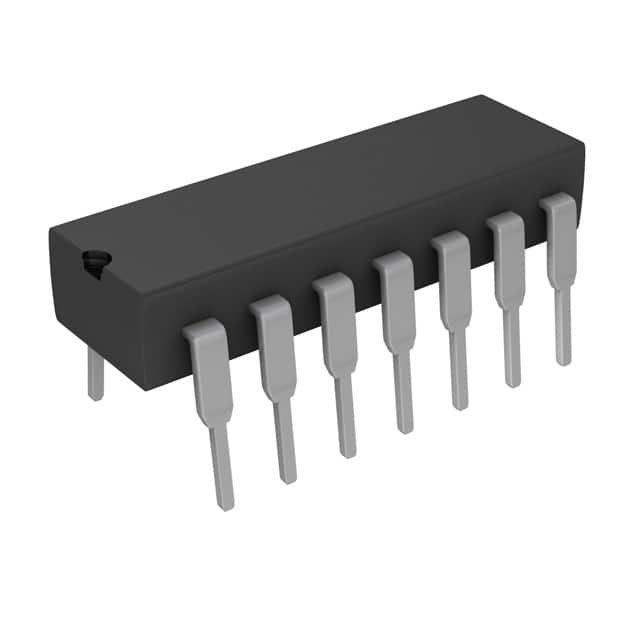Consulte las especificaciones para obtener detalles del producto.

MSP430G2111IN14
Product Overview
- Category: Microcontroller
- Use: Embedded systems, Internet of Things (IoT) devices, and low-power applications
- Characteristics:
- Low power consumption
- High performance
- Small form factor
- Integrated peripherals
- Package: IN14 package
- Essence: MSP430G2111IN14 is a microcontroller designed for low-power applications with integrated peripherals.
Specifications
- Architecture: 16-bit RISC
- CPU Speed: Up to 16 MHz
- Flash Memory: 2 KB
- RAM: 128 bytes
- Operating Voltage Range: 1.8V to 3.6V
- Digital I/O Pins: 10
- Analog Inputs: 8
- Timers: 1x16-bit Timer_A
- Communication Interfaces: SPI, I2C, UART
- Operating Temperature Range: -40°C to +85°C
Pin Configuration
The MSP430G2111IN14 microcontroller has a total of 14 pins. The pin configuration is as follows:
- P1.0 - GPIO
- P1.1 - GPIO
- P1.2 - GPIO
- P1.3 - GPIO
- P1.4 - GPIO
- P1.5 - GPIO
- P1.6 - GPIO
- P1.7 - GPIO
- GND - Ground
- RST/NMI - Reset/Non-Maskable Interrupt
- TEST - Test Mode Select
- XIN - Crystal Oscillator Input
- XOUT - Crystal Oscillator Output
- VCC - Power Supply
Functional Features
- Low power consumption: The MSP430G2111IN14 is designed to operate at ultra-low power levels, making it suitable for battery-powered applications.
- Integrated peripherals: The microcontroller includes a variety of integrated peripherals such as SPI, I2C, and UART, enabling easy communication with other devices.
- High performance: Despite its low power consumption, the MSP430G2111IN14 offers high performance with its 16-bit RISC architecture and up to 16 MHz CPU speed.
Advantages and Disadvantages
Advantages: - Low power consumption - Integrated peripherals - Small form factor - High performance
Disadvantages: - Limited flash memory and RAM capacity - Limited number of digital I/O pins
Working Principles
The MSP430G2111IN14 microcontroller operates based on the von Neumann architecture. It executes instructions fetched from its flash memory using a 16-bit RISC CPU. The integrated peripherals allow the microcontroller to communicate with external devices and perform various tasks.
Application Field Plans
The MSP430G2111IN14 microcontroller is widely used in various application fields, including but not limited to: - Home automation systems - Wearable devices - Sensor networks - Industrial control systems - Medical devices - Smart agriculture
Alternative Models
If the MSP430G2111IN14 does not meet specific requirements, alternative microcontrollers with similar features can be considered. Some alternative models include: - MSP430G2211IN14 - MSP430G2311IN14 - MSP430G2411IN14
These alternative models offer different flash memory capacities, additional features, or increased I/O capabilities while maintaining compatibility with the MSP430 family.
In conclusion, the MSP430G2111IN14 microcontroller is a versatile and efficient solution for low-power applications. Its integrated peripherals, small form factor, and high performance make it suitable for a wide range of embedded systems and IoT devices.
Enumere 10 preguntas y respuestas comunes relacionadas con la aplicación de MSP430G2111IN14 en soluciones técnicas
Sure! Here are 10 common questions and answers related to the application of MSP430G2111IN14 in technical solutions:
Q1: What is MSP430G2111IN14? A1: MSP430G2111IN14 is a microcontroller from Texas Instruments' MSP430 family, specifically designed for low-power applications.
Q2: What are the key features of MSP430G2111IN14? A2: Some key features of MSP430G2111IN14 include a 16-bit RISC CPU, 2KB Flash memory, 128B RAM, multiple I/O pins, and low power consumption.
Q3: What are the typical applications of MSP430G2111IN14? A3: MSP430G2111IN14 is commonly used in applications such as sensor nodes, battery-powered devices, home automation systems, and industrial control systems.
Q4: How can I program MSP430G2111IN14? A4: MSP430G2111IN14 can be programmed using various development tools such as Code Composer Studio, Energia IDE, or through the use of MSP430 LaunchPad development boards.
Q5: What programming language is used for MSP430G2111IN14? A5: MSP430G2111IN14 can be programmed using C or assembly language. However, higher-level languages like Energia (based on Arduino) can also be used.
Q6: How do I interface external components with MSP430G2111IN14? A6: External components can be interfaced with MSP430G2111IN14 using its GPIO pins, SPI, I2C, UART, or ADC interfaces, depending on the requirements of the specific component.
Q7: Can MSP430G2111IN14 communicate with other microcontrollers or devices? A7: Yes, MSP430G2111IN14 can communicate with other microcontrollers or devices using various communication protocols such as SPI, I2C, or UART.
Q8: How do I power MSP430G2111IN14? A8: MSP430G2111IN14 can be powered using a regulated power supply within the specified voltage range (typically 1.8V to 3.6V) or by using batteries in low-power applications.
Q9: What is the maximum clock frequency of MSP430G2111IN14? A9: The maximum clock frequency of MSP430G2111IN14 is 16 MHz.
Q10: Are there any development resources available for MSP430G2111IN14? A10: Yes, Texas Instruments provides comprehensive documentation, application notes, and example code for MSP430G2111IN14 on their website. Additionally, online communities and forums offer support and resources for developers working with MSP430 microcontrollers.
Please note that these answers are general and may vary depending on specific requirements and use cases.

